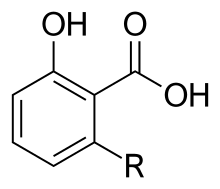Anacardic acids
Anacardic acids are phenolic lipids, chemical compounds found in the shell of the cashew nut (Anacardium occidentale). An acid form of urushiol, they also cause an allergic skin rash on contact,[1] known as urushiol-induced contact dermatitis. Anacardic acid is a yellow liquid. It is partially miscible with ethanol and ether, but nearly immiscible with water. Chemically, anacardic acid is a mixture of several closely related organic compounds. Each consists of a salicylic acid substituted with an alkyl chain that has 15 or 17 carbon atoms. The alkyl group may be saturated or unsaturated; anacardic acid is a mixture of saturated and unsaturated molecules. The exact mixture depends on the species of the plant.[2] The 15-carbon unsaturated side chain compound found in the cashew plant is lethal to Gram-positive bacteria.

Folk use for tooth abscesses, it is also active against acne, some insects, tuberculosis, and MRSA. It is primarily found in foods such as cashew nuts, cashew apples, and cashew nutshell oil, but also in mangos and Pelargonium geraniums.[3]
Experimental antibacterial properties
 | |
| Names | |
|---|---|
| IUPAC name
2-hydroxy-6-[(8Z,11Z)-pentadeca-8,11,14-trienyl]benzoic acid | |
| Identifiers | |
3D model (JSmol) |
|
| ChEMBL | |
| ECHA InfoCard | 100.031.141 |
| MeSH | anacardic+acid |
PubChem CID |
|
CompTox Dashboard (EPA) |
|
| |
| Properties | |
| C22H30O3 | |
| Molar mass | 342.4718 g/mol |
Except where otherwise noted, data are given for materials in their standard state (at 25 °C [77 °F], 100 kPa). | |
| Infobox references | |
The side chain with three unsaturated bonds was the most active against Streptococcus mutans, the tooth decay bacterium, in test tube experiments. The number of unsaturated bonds was not material against Cutibacterium acnes, the acne bacterium.[4] Eichbaum claims that a solution of one part anacardic acid to 200,000 parts water to as low as one part in 2,000,000 is lethal to Gram-positive bacteria in 15 minutes in vitro. Somewhat higher ratios killed tubercle bacteria of tuberculosis in 30 minutes.[5] Heating these anacardic acids converts them to the alcohols (cardanols) with reduced activity compared to the acids. Decarboxylation, such as through heating done in most commercial oil processing, results in compounds with significantly reduced activity.[6][7] It is said that the people of the Gold Coast (now Ghana) use cashew leaves and bark for a toothache.[8]
Industrial uses
Anacardic acid is the main component of cashew nutshell liquid (CNSL), and finds use in the chemical industry for the production of cardanol, which is used for resins, coatings, and frictional materials. Cardanol is used to make phenalkamines, which are used as curing agents for the durable epoxy coatings used on concrete floors.[9]
History
The first chemical analysis of the oil of the cashew nut shell from the Anacardium occidentale was published in 1847.[10] It was later found to be a mixture rather than one chemical, sometimes the plural anacardic acids is used.
Synergies
Anacardic acid is synergistic with anethole from the seed of anise (Umbelliferae) and linalool from green tea in vitro [Muroi & Kubo, p1782]. The totarol in the bark of Podocarpus trees is synergistic with anacardic acid in its bactericidal effects.[11]
Other and potential uses
There is also a suspicion that inhibiting anacardic acids may arrest the growth of cancer tumors such as breast cancer. [Kubo et al., 1993]
Anacardic acid (2-hydroxy-6-alkylbenzoic acid) provides resistance to small pest insects (aphids and spider mites).[12]
Anacardic acid kills methicillin-resistant Staphylococcus aureus (MRSA) cells more rapidly than totarol.[13]
List of anacardic acids
- 6-pentadecyl salicylic acid (6-PDSA), a potent HAT inhibitor from cashew nut shell liquid, and sensitizer of cancer cells to ionizing radiation.[14]
See also
- List of phytochemicals and foods in which they are prominent
References
- Rosen, T.; Fordice, D. B. (April 1994). "Cashew Nut Dermatitis". Southern Medical Journal. 87 (4): 543–546. doi:10.1097/00007611-199404000-00026. PMID 8153790.
- V. J. Paul & L. M. Yeddanapalli (1954). "Olefinic Nature of Anacardic Acid from Indian Cashew-nut Shell Liquid". Nature. 174 (4430): 604. Bibcode:1954Natur.174..604P. doi:10.1038/174604a0. S2CID 4249027.
- Romeo, Edited by John T. (2006). Integrative plant biochemistry. Amsterdam: Elsevier. p. 132. ISBN 978-0-08-045125-1.CS1 maint: extra text: authors list (link)
- Kubo, I; Muroi, H; Himejima, M (1993). "Structure - Antibacterial activity relationships of anacardic acids". Journal of Agricultural and Food Chemistry. 41 (6): 1016–1019 [1018]. doi:10.1021/jf00030a036.
- Eichbaum FW 1946 Biological properties of anacardic acid (O- pentadeca dienylsalicylic acid) and related compounds. General discussion-bactericidal action. «Memórias do Instituto Butantan», 19, pp. 71-86.
- Himejima, M; Kubo, I (1991). "Antibacterial agents from the cashew Anacardium occidentale (Anacardiaceae) nutshell oil". Journal of Agricultural and Food Chemistry. 39 (2): 418–421 [419]. doi:10.1021/jf00002a039.
- Patel NM Patel MS 1936 Cashew-nut shell oil and a study of the changes produced in the oil by the action of heat. Journal of the University of Bombay, Science: Physical Sciences, Mathematics, Biological Sciences, Medicine 5 (pt2) 114-131.
- http://www.hort.purdue.edu/newcrop/duke_energy/Anacardium_occidentale.html#Folk%20Medicine Cashew plants in folk medicine.
- Alexander H. Tullo (September 8, 2008). "A Nutty Chemical". Chemical and Engineering News. 86 (36): 26–27. doi:10.1021/cen-v086n033.p026.
- Dr. Städeler (1847). "Ueber die eigenthümlichen Bestandtheile der Anacardiumfrüchte". Annalen der Chemie und Pharmacie. 63 (2): 137–164. doi:10.1002/jlac.18470630202.
- Kubo, Isao; Muroi, Hisae; Himejima, Masaki (October 1992). "Antibacterial Activity of Totarol and Its Potentiation". Journal of Natural Products. 55 (10): 1436–1440. doi:10.1021/np50088a008. PMID 1453180.
- Schultz, David J.; Olsen, Christian; Cobbs, Gary A.; Stolowich, Neal J.; Parrott, Megan M. (1 October 2006). "Bioactivity of Anacardic Acid against Colorado Potato Beetle (Leptinotarsa decemlineata) Larvae". Journal of Agricultural and Food Chemistry. 54 (20): 7522–7529. doi:10.1021/jf061481u. PMID 17002417.
- "Antibacterial activity of anacardic acid and totarol, alone and in combination with methicillin, against methicillin-resistant Staphylococcus aureus". 80 (4). Cite journal requires
|journal=(help) - Rajendran, P; Ho, E; Williams, DE; Dashwood, RH (2011). "Dietary phytochemicals, HDAC inhibition, and DNA damage/repair defects in cancer cells". Clinical Epigenetics. 3 (1): 4. doi:10.1186/1868-7083-3-4. PMC 3255482. PMID 22247744.